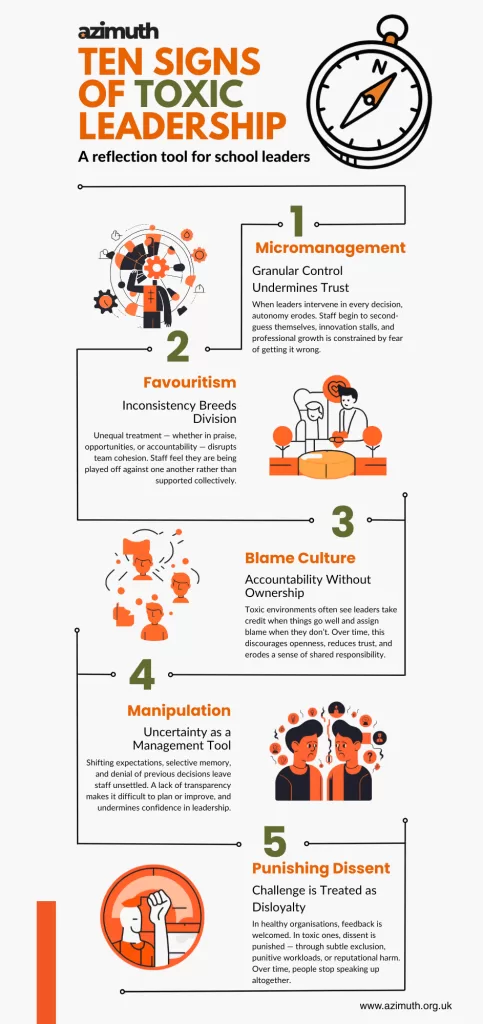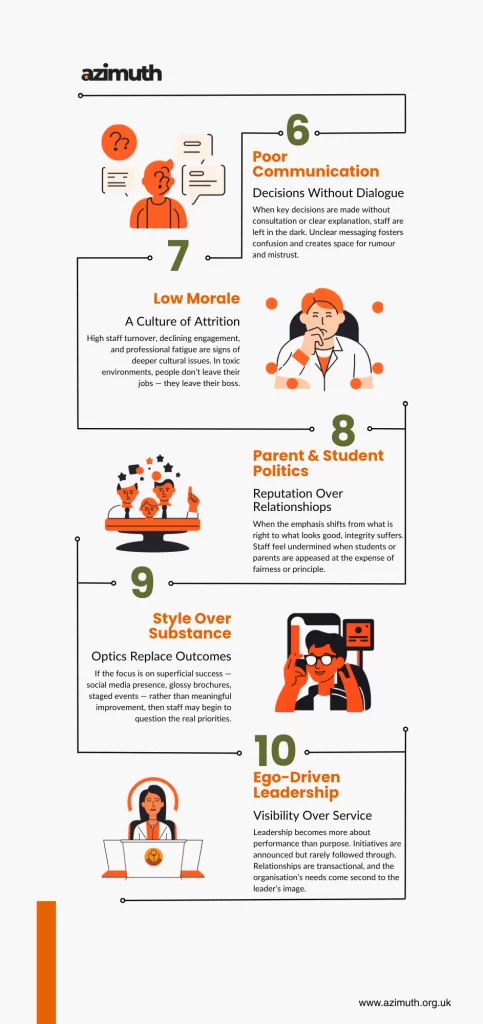
Leadership, especially in schools, is rarely toxic by intent. Most of us step into roles of responsibility with a deep sense of moral purpose — to improve the lives of young people, to shape culture, to build something better. Yet in the noise and haste of modern school life, even experienced leaders can fall into patterns that, over time, corrode trust, hinder initiative, and sap morale.
This article offers not a diagnosis but a mirror. It’s grounded in the school environment — where I have spent my career — but the signs explored here are not unique to education. They are recognisable across many professional domains and can be adapted by leaders in any setting seeking to build trust and lead with clarity and intent.
As educationalist Michael Fullan reminds us, “Effective leadership is not about cleverness or charisma — it’s about relationships, purpose, and the disciplined pursuit of improvement.” This is a guide for those who want to do just that: pause, reflect, and recalibrate.
1. Micromanagement
Overcontrol Undermines Trust
When leaders involve themselves in every decision — from pedagogy to reprograghics — they inadvertently undercut professional agency. What begins as diligence can quickly foster dependence, learned helplessness, and a reluctance to take risks.
2. Favouritism
Inconsistency Breeds Division
When some staff receive special treatment — in praise, opportunity, or accountability — others notice. This perceived inequity erodes psychological safety and encourages a culture of comparison rather than collaboration.
3. Blame Culture
Accountability Without Ownership
In schools where success is claimed by the top and failure delegated to others, staff soon retreat from innovation. A healthy culture owns mistakes, learns from them, and moves forward together. Leadership that evades responsibility weakens the whole system.
4. Manipulation
Uncertainty as a Management Tool
When expectations change without notice, when decisions are made then quietly reversed, or when previous assurances are denied — trust frays. Predictability is not bureaucracy; it is a sign of integrity.
5. Punishing Dissent
Challenge Is Treated as Disloyalty
Environments that punish constructive challenge diminish the very capacity they rely on. Over time, staff learn to nod along, regardless of their views. In truth, silence is not agreement — it is often self-preservation.
6. Poor Communication
Decisions Without Dialogue
When staff don’t understand the school’s direction, it’s not a reflection of their intelligence or engagement — it’s a leadership issue. Clear communication is not just about announcements; it’s about connection, consistency, and context.
7. Low Morale
A Culture of Attrition
Teachers rarely resign suddenly. First, they stop contributing. Then, they stop caring. Finally, they leave — often taking their insight and goodwill with them. A pattern of disengagement is a message, not a mystery.
8. Parent & Student Manipulation
Reputation Over Relationships
When the desire to please vocal parents or project polished optics outweighs the commitment to fairness and principle, staff feel expendable. Leadership becomes reactive, not values-driven.
9. Style Over Substance
Optics Replace Outcomes
There is nothing wrong with celebrating success — but when visibility becomes the goal, not the by-product, leadership drifts. The purpose of strategy is not to impress observers but to improve outcomes.
10. Ego-Driven Leadership
Visibility Over Service
The leader becomes the story. Initiatives are launched with fanfare but abandoned without evaluation. Relationships are instrumental rather than authentic. Over time, staff lose sight of the shared mission and begin to protect their own corners.


What This Tells Us
These signs are not indictments — they are invitations. Leadership begins with self-leadership: the capacity to reflect, to realign, and to lead from purpose rather than performance. In high-trust cultures, leaders take responsibility not only for outcomes, but for the conditions that shape them.
This approach isn’t unique to schools, but schools offer a sharp lens. Where relationships are close, and the stakes are high, toxic patterns show up quickly. But the solutions — empathy, clarity, humility, rigour — are as applicable in boardrooms as they are in classrooms.
How Azimuth Can Help
At Azimuth, we support serving and aspiring leaders who want to build healthier, more purposeful organisations. Whether you’re in education or another sector, we bring coaching expertise, strategic thinking, and a deep understanding of cultural change to help you navigate challenges, build capacity, and lead with greater clarity.
References and Further Reading
Brighouse, T. & Woods, D. (2009). About Our Schools: Improving on Previous Best. London: Routledge.
Buck, A. (2016). Leadership Matters: How Leaders at All Levels Create Great Schools. Woodbridge: John Catt.
Collins, J. (2001). Good to Great: Why Some Companies Make the Leap… and Others Don’t. New York: HarperBusiness.
Downey, M. (2003). Effective Coaching: Lessons from the Coach’s Coach. London: Texere.
Fullan, M. (2001). Leading in a Culture of Change. San Francisco: Jossey-Bass.
Goleman, D. (2002). The New Leaders: Transforming the Art of Leadership into the Science of Results. London: Little, Brown.
Starr, J. (2021). The Coaching Manual: The Definitive Guide to the Process, Principles and Skills of Personal Coaching. 5th ed. Harlow: Pearson.
Wiliam, D. (2016). Leadership for Teacher Learning: Creating a Culture Where All Teachers Improve So That All Students Succeed. West Palm Beach: Learning Sciences International.
“The moment a leader allows himself to become the primary reality people worry about, rather than reality being the primary reality, you have a recipe for mediocrity, or worse.”, evidence, and disciplined thought.”
Jim Collins

Subscribe to our newsletter
- Actionable insights on leadership, learning, and organisational improvement
- Thought-provoking reflections drawn from real-world experience in schools and beyond
- Curated resources on effective practice and digital strategy
- Early access to new articles, events, and consultancy updates
- Invitations to subscriber-only webinars, Q&As, and informal conversations
- Clarity, not clutter—you will not be bombarded by emails
Cancel or pause anytime.

Leave a Reply